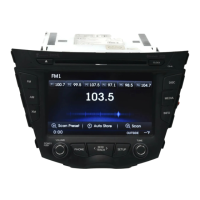
Do you have a question about the Hyundai VELOSTER TURBO 2015 and is the answer not in the manual?
| Brand | Hyundai |
|---|---|
| Model | VELOSTER TURBO 2015 |
| Category | Automobile |
| Language | English |
Controls for front windshield defrosting for clear visibility.
Steps for pairing a phone and using Bluetooth hands-free functions.
Overview of Blue Link services including remote access and safety features.
How to set the vehicle's clock and daylight savings time.
Instructions for using the navigation system to find destinations.
Explanation of the TPMS indicator light and malfunction alerts.
How to adjust vehicle settings through the instrument cluster.
How to use the key fob for locking, unlocking, and accessing the mechanical key.
Operating the engine start/stop button for ignition, starting, stopping, and emergencies.
How to adjust the front seat's forward/backward position, height, and angle.
Instructions for raising and lowering the headrest.
How to properly adjust the driver's seat belt extension guide.
How to adjust the steering wheel's tilt and telescopic position.
Instructions for opening and closing the fuel filler door.
Operation of power windows, mirror controls, and door locks.
How to operate headlights, fog lights, turn signals, and high beams.
How to use the front and rear wipers and washers, including intermittent settings.
How to open, close, and tilt the sunroof.
How to operate the map and room lamps.
How to enable or disable the rear door child safety lock.
Explanation of various warning lights and indicators on the instrument panel.
How to adjust the brightness of the instrument panel lighting.
How to navigate and view information on the trip computer.
Using manual controls for temperature, fan speed, and air intake.
Steps for clearing the front windshield using defrost controls.
How to activate and deactivate the rear window defroster.
Using automatic settings for temperature, fan speed, and air intake.
Steps for clearing the front windshield using automatic controls.
How to activate and deactivate the rear window defroster.
How to set, adjust, and cancel cruise control speeds.
Using steering wheel buttons for volume, mode, and presets.
How to use steering wheel buttons for calls and voice commands.
Advice for clear audio during Bluetooth calls in various driving conditions.
Using voice commands for phone, navigation, and other vehicle functions.
Step-by-step guide to pairing a smartphone with the vehicle.
Introduction to Blue Link services and voice response commands.
Using the mobile app to lock/unlock doors, manage PIN, and set delays.
Turning on the radio, tuning channels, and setting presets.
Understanding the map display and entering destinations via address or POI.
How to play Pandora through the vehicle's audio system via Bluetooth.
Connecting external audio, video, or iPod devices using the provided ports.
Understanding the shift lever positions (P, R, N, D, Ds) and paddle shifters.
How to activate Sport mode for a more dynamic driving experience.
Procedures for shifting gears in a manual transmission, including reverse.
Explanation of TPMS malfunction indicator and low tire pressure warnings.
How the rearview camera activates when the vehicle is in Reverse.
How to set the clock and operate the seat warmer function.
How to turn the ESC system on or off for improved vehicle control.
How the Active ECO system improves fuel efficiency and its operational impact.











